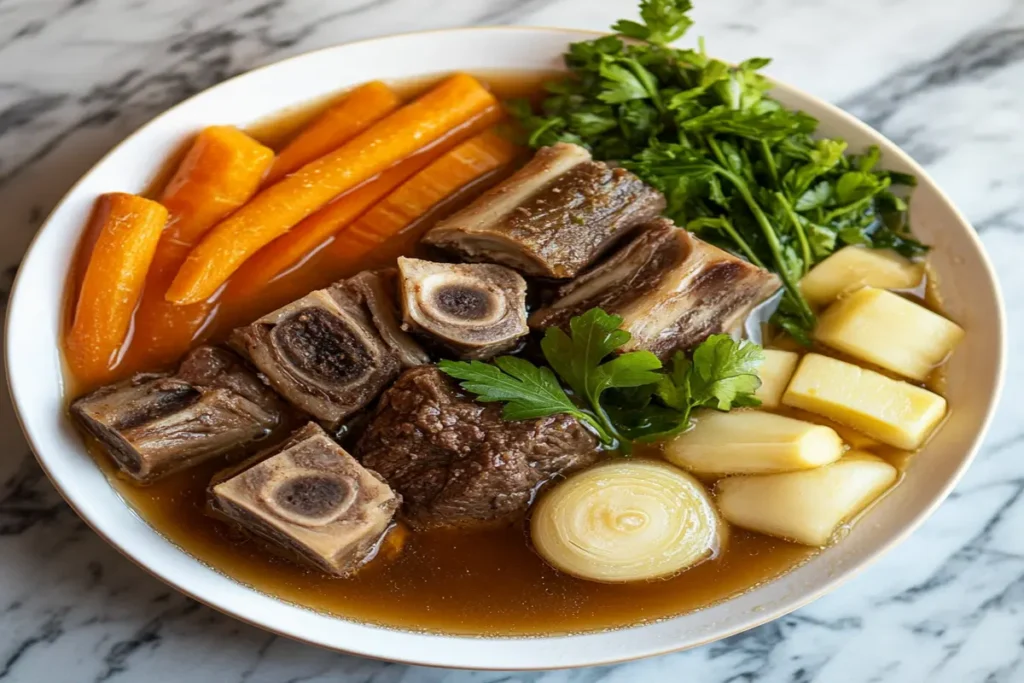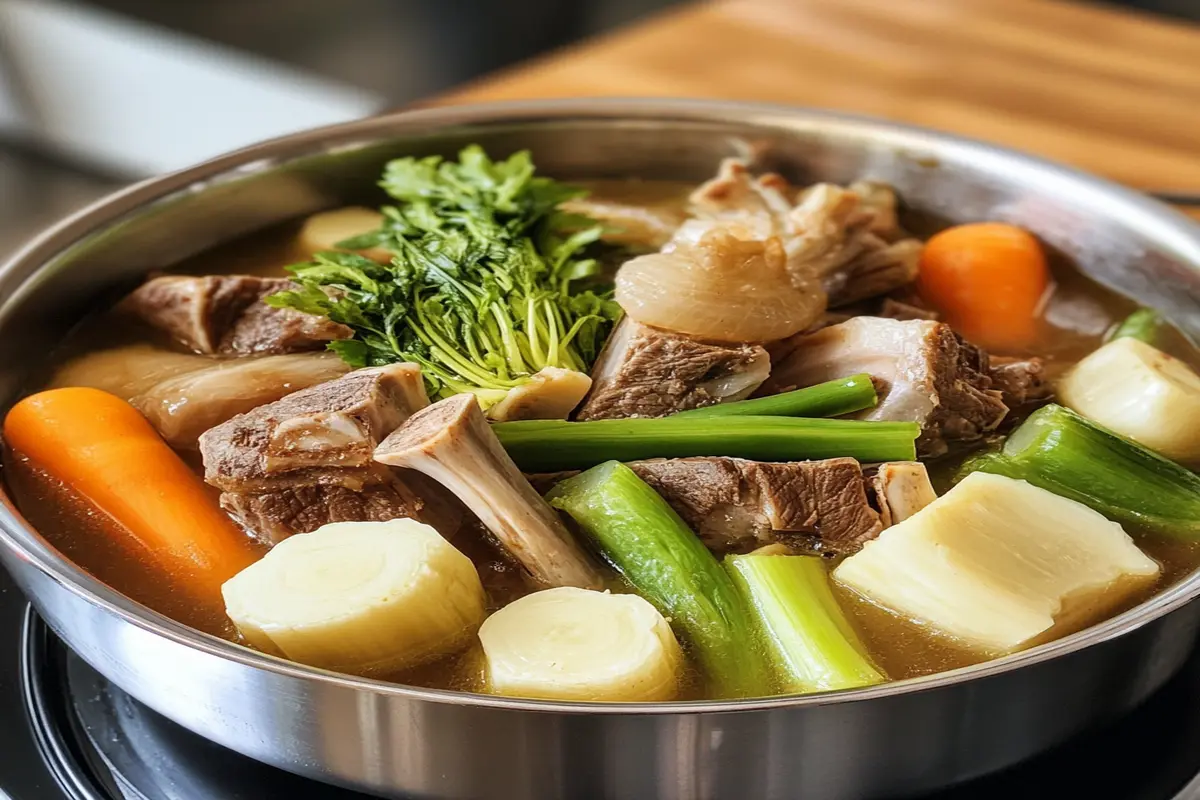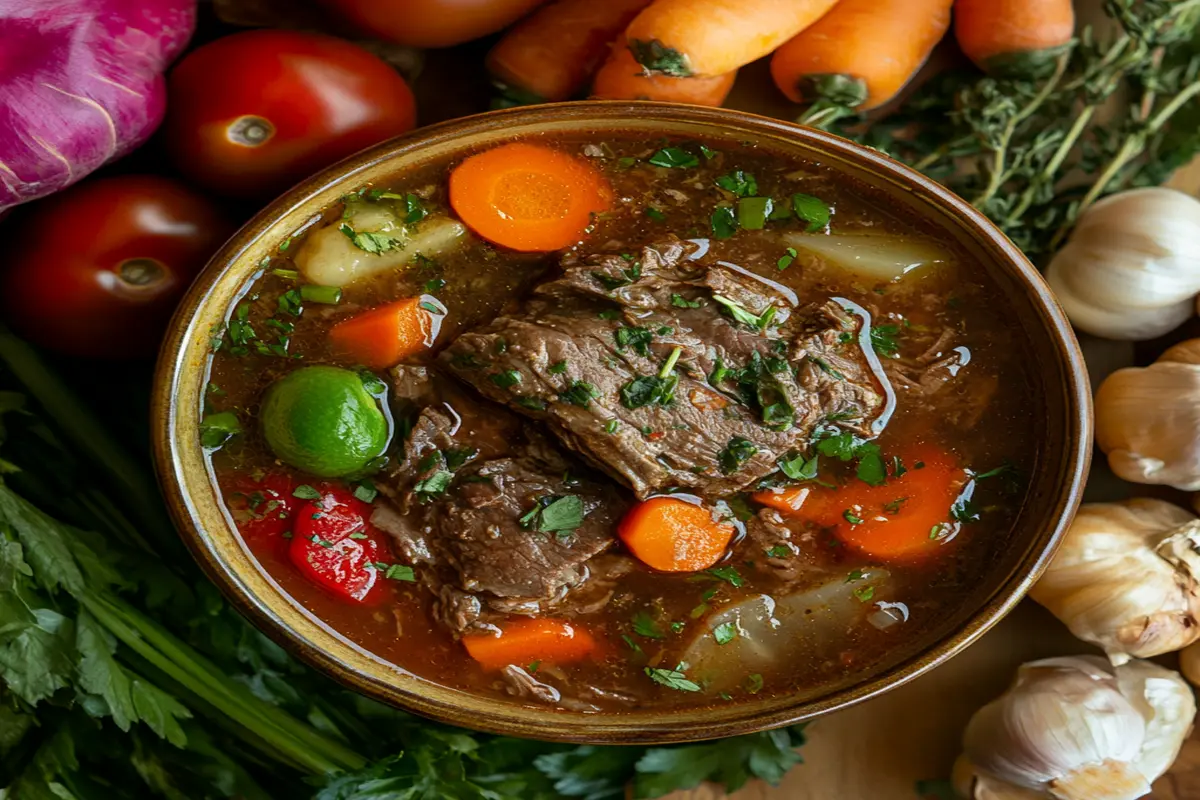Beef bouillon is a pantry staple that has stood the test of time, delivering rich, savory flavor to countless dishes. From enhancing soups and stews to acting as a base for sauces, it’s versatile, flavorful, and surprisingly easy to use. But what exactly is beef bouillon, how is it made, and why does it hold such an essential place in kitchens around the globe?
In this comprehensive guide, we’ll explore everything you need to know about beef bouillon. From its history and preparation to its health benefits and uses, we’ve got you covered. Plus, you’ll learn how to make your own homemade beef bouillon for a more personal touch. Let’s dive in!
Introduction
What is Beef Bouillon?
At its core, beef bouillon is a concentrated broth made by simmering beef bones, meat, and aromatics until the essence of the ingredients is fully extracted. The liquid is then reduced and often dehydrated into cubes or granules for convenience. This compact flavor bomb is a go-to ingredient for chefs and home cooks alike, offering an instant boost to the taste of dishes.
The word “bouillon” comes from the French term for “boiling,” reflecting its origins in traditional European kitchens. It has since become a global favorite, with versions tailored to various culinary traditions.
History and Origins of Beef Bouillon
The journey of beef bouillon dates back centuries, originating as a way to preserve the rich flavors of meat for extended periods. Early recipes often included herbs, spices, and vegetables to create a well-rounded taste. By the 19th century, bouillon cubes and powders emerged, revolutionizing the way people cooked by introducing convenience without sacrificing flavor.
Today, beef bouillon remains a cornerstone of culinary innovation, from its use in gourmet recipes to its role as a comforting drink. The simplicity and depth it brings to the table explain why it has stood the test of time.
How is Beef Bouillon Made?
Key Ingredients in Beef Bouillon

The core of any good beef bouillon lies in its ingredients. High-quality beef bones, packed with marrow, are essential. These bones release rich flavors and nutrients when simmered. Aromatics like onions, carrots, and celery enhance the depth of the broth. Spices such as bay leaves, thyme, and black peppercorns are often added to balance the taste.
Commercially, bouillon may include flavor enhancers like monosodium glutamate (MSG) or preservatives. However, homemade bouillon prioritizes freshness and natural components, making it a healthier option.
The Process of Making
The journey to creating beef bouillon begins with roasting beef bones and vegetables. This step caramelizes the natural sugars, boosting flavor. The roasted ingredients are then simmered in water for several hours to extract every ounce of goodness.
Once the broth is rich and fragrant, it is strained to remove solids. The liquid is further reduced to concentrate the flavor. For those making bouillon cubes or powder, the reduction undergoes dehydration to achieve the desired texture. This process ensures the bouillon is compact and easy to store.
Variations: Cubes, Powder, and Liquid
Beef bouillon comes in various forms to suit different needs. Bouillon cubes are the most convenient, offering a long shelf life and portability. Powdered bouillon dissolves quickly, making it ideal for quick recipes. Liquid bouillon, though less common, delivers a fresh and robust taste.
Each variation has its place in the kitchen. For instance, cubes are perfect for hearty stews, while powdered bouillon works well in marinades.
Beef Bouillon vs. Beef Broth: What’s the Difference?
Defining Beef Bouillon and Beef Broth
While beef bouillon and beef broth may seem interchangeable, they have distinct differences. Bouillon is a concentrated form of broth, often dehydrated into cubes or granules for convenience. Broth, on the other hand, is a liquid product used as is, without additional processing.
Texture, Flavor, and Usage Differences
The concentration process gives beef bouillon a more intense flavor, making it a powerful seasoning agent. Broth, with its lighter taste, is better suited for sipping or serving as a soup base.
In terms of texture, bouillon tends to dissolve completely, integrating seamlessly into dishes. Broth, being liquid, adds volume along with flavor.
Choosing the Right Option for Recipes
Deciding between beef bouillon and broth depends on the recipe. If you’re making a sauce or need a concentrated flavor boost, bouillon is your best bet. For hearty soups or risottos, broth offers a more delicate touch.
Internal Link Suggestion: Consider linking to this guide on beef back ribs for readers who might enjoy pairing beef bouillon with grilled beef recipes. Let me know if you’d like further optimization!
Benefits of Consuming
Nutritional Profile
When it comes to nutrition, beef bouillon delivers plenty of essential minerals. For example, potassium, calcium, and magnesium, often extracted from beef bones during simmering, contribute to its nutritional value. Moreover, some bouillons contain collagen, which can support joint health and improve skin elasticity. However, store-bought options may include higher levels of sodium, so homemade versions are usually a healthier choice.
Health Benefits: Hydration, Electrolytes, and More
Drinking beef bouillon is not only comforting but also hydrating. For instance, its blend of water and electrolytes makes it an excellent option for replenishing fluids after illness. Additionally, the low-calorie nature of bouillon suits individuals on weight-loss diets or restrictive meal plans. For those seeking gut health benefits, the collagen and amino acids found in bone-based bouillon may aid in digestion and reduce inflammation.
Is Beef Bouillon Good for You?
Absolutely! When consumed in moderation, beef bouillon provides key nutrients while enhancing flavor. It supports hydration, supplies electrolytes, and serves as a satisfying, nutrient-rich addition to your diet. If sodium levels are a concern, opting for a homemade or reduced-sodium variety is a smart move. Bouillon, however, is a concentrated form, often dehydrated for ease of use, which makes it ideal for adding intense flavor quickly.
: Cooking with Beef Bouillon
How to Use Beef Bouillon in Soups and Stews
One of the most common uses for beef bouillon is in soups and stews. For example, dissolving a cube in boiling water creates a flavorful broth base, perfect for enhancing recipes like beef and vegetable stew. Additionally, it works wonders as a pan deglazer, helping to craft rich sauces and gravies. By adding bouillon to soups, you’ll instantly notice the depth and warmth it brings to your dishes.
Enhancing Flavors in Other Dishes
Besides soups, beef bouillon has a multitude of other uses. For instance, try sprinkling a bit of powdered bouillon into mashed potatoes, or mix it into marinades to elevate your dishes. Furthermore, replacing water with bouillon-based stock in rice dishes transforms plain grains into something extraordinary. In fact, bouillon provides a fast way to make everyday meals more exciting.
Creative Recipes Featuring
The versatility of beef bouillon opens the door to countless creative recipes. Use it in savory pies to add a deeper umami flavor or incorporate it into meatloaf for extra moisture. Additionally, bouillon enhances the flavor of casseroles and risottos, making it indispensable for a wide range of dishes. Bouillon, however, is a concentrated form, often dehydrated for ease of use, which means a little goes a long way in your recipes.
Making Homemade
Why Make Your Own?
Making your own beef bouillon ensures unmatched flavor and freshness. Store-bought options often include preservatives, artificial flavors, and high sodium levels. Homemade bouillon allows you to control the ingredients, tailoring the taste to your preferences.
When you create bouillon at home, you can use leftover beef bones and vegetable scraps, making it an economical and environmentally friendly choice. The process is simple, and the results are both healthier and more flavorful. Additionally, freezing homemade bouillon provides you with a convenient, ready-to-use ingredient for countless recipes.
Step-by-Step Guide to Homemade
- Gather Ingredients: Use beef bones, onions, carrots, celery, garlic, bay leaves, thyme, and peppercorns. Include water and a splash of vinegar to extract minerals from the bones.
- Roast the Bones: Roast the bones and vegetables in the oven at 400°F (200°C) for 30 minutes to enhance the flavor through caramelization.
- Simmer the Stock: Place the roasted ingredients in a pot, add water to cover, and bring to a boil. Simmer gently for 8–12 hours while skimming impurities from the surface.
- Strain and Reduce: Strain the liquid through a fine sieve to remove solids. Continue simmering the broth until it reduces into a thick, concentrated form.
- Store It: Freeze the bouillon in ice cube trays or airtight containers for easy use later.
Storing and Using Homemade Bouillon
Store your homemade beef bouillon in the freezer for up to six months. Add the frozen cubes to soups, stews, sauces, or rice dishes to enhance the flavor. By keeping it on hand, you ensure a healthier, preservative-free option for cooking.

FAQs About
What is Beef Bouillon Made Of?
Beef bouillon combines beef bones, meat, and aromatics such as onions, carrots, and celery. Simmering these ingredients extracts rich flavors and nutrients. The process concludes by reducing the broth into a concentrated form, often dehydrated into cubes or powder for convenience. Homemade versions can include fresh herbs and spices, giving you a more customizable flavor profile.
Can You Substitute Bouillon for Broth?
Yes! works as an excellent substitute for broth. Dissolve the bouillon in water to create a flavorful liquid similar to broth. This substitution works perfectly in recipes where you need a beefy flavor and don’t have broth readily available.
Are Beef Broth and Bouillon the Same?
No, they are not the same. Many ask, Are beef broth and bouillon the same? While broth is a ready-to-use liquid simmered with meat or bones, bouillon is a concentrated form. Bouillon often comes in cubes or powder, making it easy to store and use. Both are staples in cooking, but bouillon’s compact form makes it ideal for quick meals.
How Do You Use Beef Bouillon?
Dissolve in hot water to create a base for soups, stews, and sauces. Add powdered bouillon to marinades or sprinkle it over vegetables for added flavor. Whether you use it in casseroles, risottos, or as a drink, it’s a versatile ingredient for all kinds of dishes.
Conclusion
Summarizing the Versatility
a valuable ingredient that transforms ordinary dishes into something extraordinary. It’s versatile, convenient, and ideal for busy cooks. By incorporating it into soups, stews, or even casseroles, you can create meals bursting with flavor.
Many wonder, Are beef broth and bouillon the same? Although similar, bouillon offers a concentrated form that is dehydrated into cubes or powder, while broth is a liquid ready to use. Both have their unique strengths, but bouillon stands out for its ease of storage and powerful flavor.
Final Tips for Maximizing
Explore different recipes and experiment in new ways. Opt for homemade bouillon for a fresh, preservative-free option, or choose high-quality store-bought alternatives for convenience. No matter your choice, this flavorful ingredient will remain a trusted kitchen essential.
Additional FAQs and Resources
What is the Shelf Life ?
Store-bought cubes or powder typically last up to two years when kept in a cool, dry space. Homemade bouillon, stored in the freezer, remains fresh for three to six months without compromising its flavor.
Can Vegetarians Use Bouillon?
Yes, vegetarian options exist! While traditional beef bouillon contains animal products, vegetarian alternatives use vegetables, herbs, and spices to replicate the flavor. These options cater to dietary restrictions while preserving the taste.
Are Beef Broth and Bouillon the Same?
No, they serve different purposes. Many ask, Are beef broth and bouillon the same? Broth is a liquid cooked with beef and vegetables, ready to use in recipes. Bouillon, however, is a concentrated form, often dehydrated for ease of use.
Where to Find More Recipes Using ?
Explore recipes like The Ultimate Beef Nachos for creative ways to . Whether in casseroles, marinades, or sauces, bouillon adds depth and richness to every dish. incredible flavor-boosting power of this simple yet dynamic ingredient.

